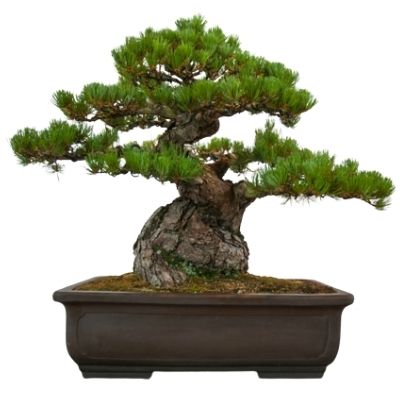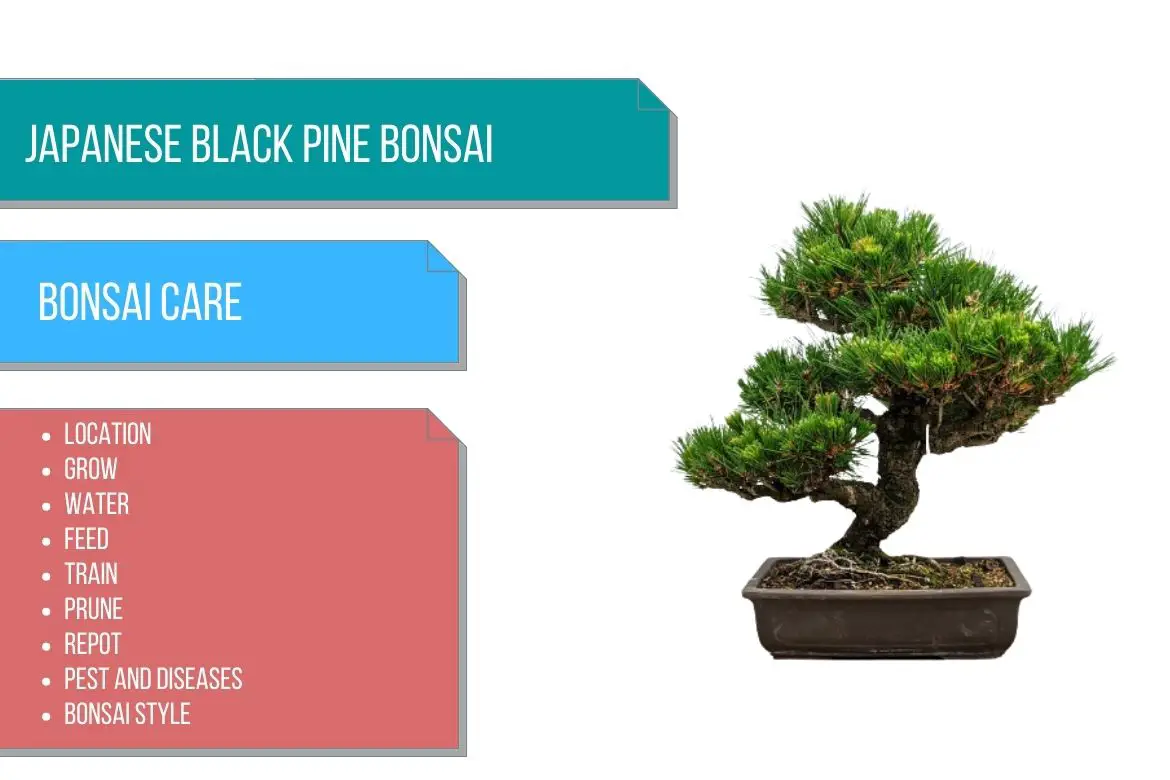
Japanese black pine
(Pinus thunbergii)
Country of Origin : Korea & Japan
Bonsai Styles : Informal or formal upright, slanting, semi-cascade, or cascade.
Zone : 5 – 8
A black-gray tree with rough, furrowed bark and orange-yellow young shoots, Japanese black pine is an evergreen tree.
Quite young black pine trees develop deep fissures in the charcoal-gray bark, and the branches thicken and mature fairly quickly.
Compared to the softer look of white pine (Pinus parvifiora), these characteristics create a strong, rugged and masculine appearance. Continue reading Japanese white pine bonsai care.
Bonsai trees made from this pine are highly regarded in Japan.
Although it is less common outside Japan as a bonsai specimen, it is still popular among bonsai enthusiasts worldwide.
The black pine can survive on impoverished, stony soils.
This tolerance makes its rootstock ideal for grafting the softer-looking Pinus parvifiora, the Japanese white pine.
Many bonsai growers prefer pines, and Japanese black and white pines are among the most popular pine varieties.
When established on medium to large bonsai trees, formal or informal styles (with triangular or square shapes) are easy to maintain. However, these styles are more difficult to maintain on smaller black pine trees due to needle length.
Japanese black pine tree bonsai that is smaller in size must have a much simpler structure in order to succeed.
Long, shiny, dense, dark green needles are arranged in pairs and held firmly upright on the shoots of this tree.

Read more about other bonsai trees species in : Types of bonsai tree
Best location keep Japanese black pine Bonsai
Japanese black pines thrive in direct sunlight. They should not be kept indoors or behind glass windows as they block UV light and can cause heat spots. The more unfiltered sunlight the tree receives, the better. Continue reading outdoor bonsai tree care.
The growth of semi-shaded black pine bonsai tree is weak and budding is poor. Refer to do bonsai trees need sunlight for more indoor and outdoor bonsai location ideas.
In winters, protect the Japanese black pine bonsai from prolonged exposure to temperatures below 23°F (-5°C).
Japanese black pines are coastal trees and are not as tolerant of freezing temperatures. Protection is necessary when temperatures drop below freezing. The tree should be placed in an unheated garage or a greenhouse to safeguard it from frost.
For more information on how to keep your outdoor bonsai thriving in different seasons of the year, please read seasonal care for bonsai trees.
Also, protect the tree from cold winds and excessive rain.
Propagation Japanese black pine
Black pine can be propagated in the winter season.
Fresh seeds should be soaked overnight. Fresh seeds ensure germination of the tree.
Discard the seeds which float and only use the seeds which sink to the bottom.
Place the seeds outside exposed to the frost. However, keep the seeds protected from birds and rodents.
Grafting of the cultivators can be done in late winter or early spring.
Watering Japanese black pine Bonsai
Black pine bonsai tree is drought-resistant, but it appreciates plenty of water if the soil drains quickly.
Do not saturate the soil, but keep it moist.
For the sake of safety, it is best to shelter pines from prolonged rainfall, as they prefer very free-draining soil.
Monitor the soil daily. Water whenever the soil is dry. During the growing season, watering may be required two to three times a day, depending on the environment and soil composition.
Wind and environmental conditions, such as rainfall, aridity, and airflow, can influence watering frequency. Windy conditions may increase transpiration, requiring more frequent watering.
Water the black pine plant sparingly in winter.
Continue reading about how to water a bonsai tree.
Wiring Japanese black pine Bonsai
Wiring young shoots of the black pine bonsai is easy as they are pretty flexible.
Wiring can be done with aluminum or copper wire.
Fall or spring season is preferred for wiring Japanese black pine bonsai.
Be sure to remove wires before they cut into the bark.
Please read our detailed guide on how to wire a bonsai tree. Also, refer to our detailed bonsai tools guide and how to take proper care of your bonsai tools to know about all the tools of bonsai.
Pruning Japanese black pine Bonsai
When to prune Japanese black pine bonsai?
Pruning can be done in early fall or late summer. At this time the wounds have less chances of bleeding resin. This resin will stain the bark.
Wounds should be sealed immediately.
Consider leaving a stub and forming it into a jin when removing branches.
Maintain proper branch proportions by pruning the outer branches back to the adventitious shoots, that appear on older wood.
Once these branches are wire trained, they can grow on to replace the outer twigs until they are pruned back and the process can be repeated.
The growth season should be a time of removing long main shoots and trimming 1/3 to 1/2 of the new candles on smaller shoots.
Every other year, prune branch tips. Remove old needles and crowded twigs in late summer or early fall to let sunlight in.
If you wish to control the growth of the needles of black pine, you can use the following technique:
- In spring season, allow the candles to extend. Pinch them back as you do normally.
- Wait for the needles to reach their ideal length (before the needles or the shoots have reached full maturity).
- At this time, stop watering the plant. You will observe that the needles have stopped growing any longer.
- Once the needles are standing upright firmly from the shoot and are hardened (color of the needles will darken), resume with watering.
- Remember that this will only affect the current year’s needle crop. To maintain uniform needle length, you must repeat this process every year.
Refer to how to prune a bonsai tree for more info on best practices and tips and tricks.
Pinching Japanese black pine Bonsai
Pinch overgrown shoots as soon as needles begin to appear to maintain compact foliage. In late summer, break off the tips of the new shoots and pull out all the old needles.
To ensure even energy distribution, needle plucking is necessary. Removing some needles allows the tree to allocate energy more evenly and promotes better growth and health. This will also promote back budding.
Repotting Japanese black pine Bonsai
When to repot Japanese black pine bonsai?
Black pine bonsai tree can be repotted every 2 to 5 years in early spring when the candle buds start to swell. Younger plants every 2 years, while older plants every 5 years. This also depends on the root development.
When untangling the roots, take care not to tear them.
The amount of root mass to be cut depends on the tree’s health and stage of development. In refinement, only a small portion of the root system is removed, while in development, up to 50% of the root mass can be cut.
You’re in luck if you notice fluffy white stuff around the roots. The fungus aids in the digestion of nutrients by the tree.
After repotting, it is crucial to provide partial shade and protect the tree from wind for about two weeks. Gradually reintroduce the tree to full sunlight afterward.
Japanese black pines prefer well-draining soils that provide a balance of water and oxygen.
Use a free-draining bonsai soil mix. Mix 20 percent organic matter with 80 percent grit.
OR
Use akadama with 30% grit.
OR
One part akadama, one part pumice, and one part lava rock
There are many experts who use 100% grit, but moisture content must be checked daily.
You can read how to repot a bonsai tree to know more about the best guidelines to follow while repotting.Also, continue reading about how to make bonsai soil at home and how to choose a pot for your bonsai.
Feeding Japanese black pine Bonsai
During the spring and summer, apply a balanced fertilizer. In the fall and early winter, use a low-nitrogen fertilizer.
OR
Half-strength solution of balanced feed applied throughout summer, one nitrogen-free feed applied in fall, plus slow-release organic fertilizer applied in mid winter.
Don’t feed the plant after de-candling. Wait until the secondary candles have hardened.
Continue reading about bonsai fertilizer and its application.
Diseases and pest of Japanese black pine Bonsai
If the soil remains wet for too long, black pines are susceptible to root rot.
You can prevent this problem by ensuring that the soil is extremely free-draining and sheltering the tree from prolonged rainfall, especially during the winter.
Sap-rich shoots and needles attract woolly aphids, mealy bugs, adelgids, and other undesirables.
Mix a drop of detergent with a systemic insecticide in water. Apply this to get rid of these pests. The detergent will help in penetrating the waxy coating on insect’s body.
Refer the in-depth guide for bonsai pest and diseases identification and treatment for more details. Also, read best practices to keep your bonsai pest free.
Japanese black pine bonsai care
Overwatering is probably the biggest risk. Yellow needles, and reduced bark budding, will result from too much water.
The soil should be checked every day, and the tree should be watered only if there are signs of dryness (unless you are using a needle-reduction technique mentioned earlier in the pruning section).
You should be especially cautious during the winter months. Though fully hardy, the roots may suffer if frozen for an extended period.
Branches that have just been pruned are at risk of dieback if they are exposed to frost too soon.
What to look for when buying Japanese black pine tree Bonsai
Black pine grows fairly fast, which contributes to some bonsai having long, immature branches that lack character.
Whenever possible, it is a good idea to look for specimens that have a good, rugged trunk and branches.
Always try and confirm the good root structure of the plant. Since black pine is grown from seeds, the plant must have a well formed root structure.

